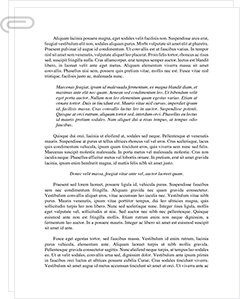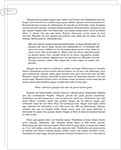Likewise, Ezra Pound put forth another modernist aesthetic theory, which was founded on the concept of imagism. He proposed that emotion always creates a pattern in the mind of the author, and thus, the work of art is created following that pattern:
Intense emotion causes pattern to arise in the mind-if the mind is strong enough. Perhaps I should say, not pattern, but pattern-units, or units of design. (I do not say that intense emotion is the sole possible cause of such units. I say simply that they can result from it. They may also result from other sorts of energy.)(..)" by pattern-unit or vorticist picture I mean the single jet. The difference between the pattern-unit and the picture is one of complexity. The pattern-unit is so simple that one can bear having it repeated several or many times. When it becomes so complex that repetition would be useless, then it is a picture, an 'arrangement of forms'.
Not only does emotion create the 'pattern-unit' and the 'arrangement of forms', it creates also the Image." (Pound, 374)
Thus, in Pound's view, the image and the pattern of emotion that leads to it is much more than a simple idea or thought:
Emotion seizing up some external scene or action carries it intact to the mind; and that vortex purges it of all save the essential or dominant or dramatic qualities, and it emerges like the external original. In either case the Image is more than an idea. It is a vortex or cluster of fused ideas and is endowed with energy." (Pound, 375)
Thus, according to Pound the every poem is made of these vortexes, that have an energy of their own, and can engage the mind of the reader, and not, as it was supposed, by mere artistic expression of different ideas or thoughts. He believes that "emotion is an organiser of form," that is, it is what determines the particular arangement of details in a poem, and also its music or rhythm:
The vorticist maintains that the 'organising' or creativeinventive faculty is the thing that matters; and that the artist having this faculty is a being infinitely separate from the other type of artist who merely goes on weaving arabesques out of other men's 'units of form'." (Pound, 377)
Another modernist aesthetic concept related to those discussed above is Joyce's epiphany, which resembles the "objective correlative" Eliot talked about, in that it defined artistic emotion as resembling an illumination which arises at the contact with certain objects or particular events:
Epiphany may be defined as "a sudden spiritual manifestation, whether from some object, scene, event, or memorable phase of the mind -- the manifestation being out of proportion to the significance or strictly logical relevance of whatever produces it."
In Stephen Hero we are told that Stephen plans on "collecting many such moments together in a book of epiphanies" (SH211)" (Cohn, 3)
All the aesthetic concepts discussed above point to the shift that took place in modernist literature which became much more concerned with artistic technique on the one hand, and also started pointing to the fact that the literary means are not those that were proposed by traditional criticism: art is not primarily inspirational, but is created according to certain formal patterns. The formal patterns are indeed determined by emotion, but not are not solely resuming or translating the emotion, instead they are recreating it in an impersonal or objective form.
As Dante put it, poetry is "That melody which most doth draw,/the soul into itself." (Pound, 362), that is a formal construct that works as a vortex of emotions and thoughts, and not a mere description of these.
Works Cited
Cohn, Allan M. Work in Progress: Joyce Centenary Essays, Illinois: Southern Illinois University, 1993
Eliot, Thomas Stearns Sacred Wood, http://www.bartelby.com/200/sw4.html
Eliot, Thomas Stearns the Waste Land, http://eliotswasteland.tripod.com
Pound Ezra Selected Prose, 1909-1965, New York: New Directions, 1973
Yeats, William Butler Essays and Introductions, New York: The Macmillan Company, 1961
Yeats, William Butler Among School Children, http://www.webbooks.com/Classics/Poetry/Anthology/Yeats/Among.htm
Eliot, Thomas Stearns Tradition and the Individual Talent, http://www.bartelby.com/200/sw4.html
Eliot, Thomas Stearns Hamlet and His Problems, http://www.bartelby.com/200/sw4.html
Eliot, Thomas Stearns Tradition and the Individual Talent, http://www.bartelby.com/200/sw4.html
Sample Source(s) Used
Works Cited
Cohn, Allan M. Work in Progress: Joyce Centenary Essays, Illinois: Southern Illinois University, 1993
Eliot, Thomas Stearns Sacred Wood, http://www.bartelby.com/200/sw4.html
Eliot, Thomas Stearns the Waste Land, http://eliotswasteland.tripod.com
Pound Ezra Selected Prose, 1909-1965, New York: New Directions, 1973
Related Documents
 Study Document
Study Document
Modernist Movement
Tarsila Do Amaral One of the most important Brazilian artists of the 20th century, Tarsila do Amaral, was born in Sao Paulo in 1886. She had a privileged childhood as the grandchild of a rich farmer. This brought with it various advantages, including an education that taught her to read, write, embroider and speak French (Damian, 1999). Finishing her studies in France and returning to Brazil, this artist left an impression
 Study Document
Study Document
Urban Planning Theories Problems Weaknesses and Solutions
Case Study: Historical Context of American Urban PlanningIntroductionThe American urban planning movement grew out of 19th century desire of aristocrats to improve their surroundings (Stormann, 1991). One of the earliest movements was the \\\"City Beautiful\\\" movement of the 1890s, which sought to design cities with aesthetically pleasing spaces and promote civic pride. This movement peaked in the early 20th century and left a legacy of urban parks and public monuments
 Study Document
Study Document
Romanticism Art Help Roger Fry
All of the styles inspired by the Romantic current can be clearly traced from the Formalist point-of-view, as they had in common the use of image itself, leaving meaning and content to a secondary design. In the poetry and literature world, the Romantic period was a chance to explore the inner feelings of the artist, the development of his own soul and thoughts, where the author is the hero of the
 Study Document
Study Document
Cubism Cubist Sculpture Cubist Sculpture
In essence the Cubists were not only concerned with the development of new artistic techniques, but their experimentation was also concerned with the search for a new and more dynamic perception of reality. As one commentator notes; "The Cubists sought to create spatial abstractions" (the AESTHETIC). As has been stated, Cubism depicts a new reality which was also in essence a form of protest against conventional ideas of both art
 Study Document
Study Document
Adolf Loos 1870-1933 Is Considered
However, his work was not always well accepted and the there was a public outcry at the minimalist and bare design of this building. Another aspect of his designs that should be mentioned was his fondness for the use of natural materials in his buildings. He "...skillfully manipulated classical materials including marble, onyx, wood, and mirror, into a careful composition of visual patterns" (ArtandCulture Artist: Adolf Loos). Other important constructions
 Study Document
Study Document
Walter Gropius
Walter Gropius Germany's high culture of the late medieval period was followed by a slow decline. In the seventeenth century the Thirty Year's War wrecked her material and political potential for more than a century. In the late eighteenth century, during a period of political importance, classic German literature was produced in the small princely courts. In the early nineteenth century, a thin layer of highly cultivated individuals began to produce



